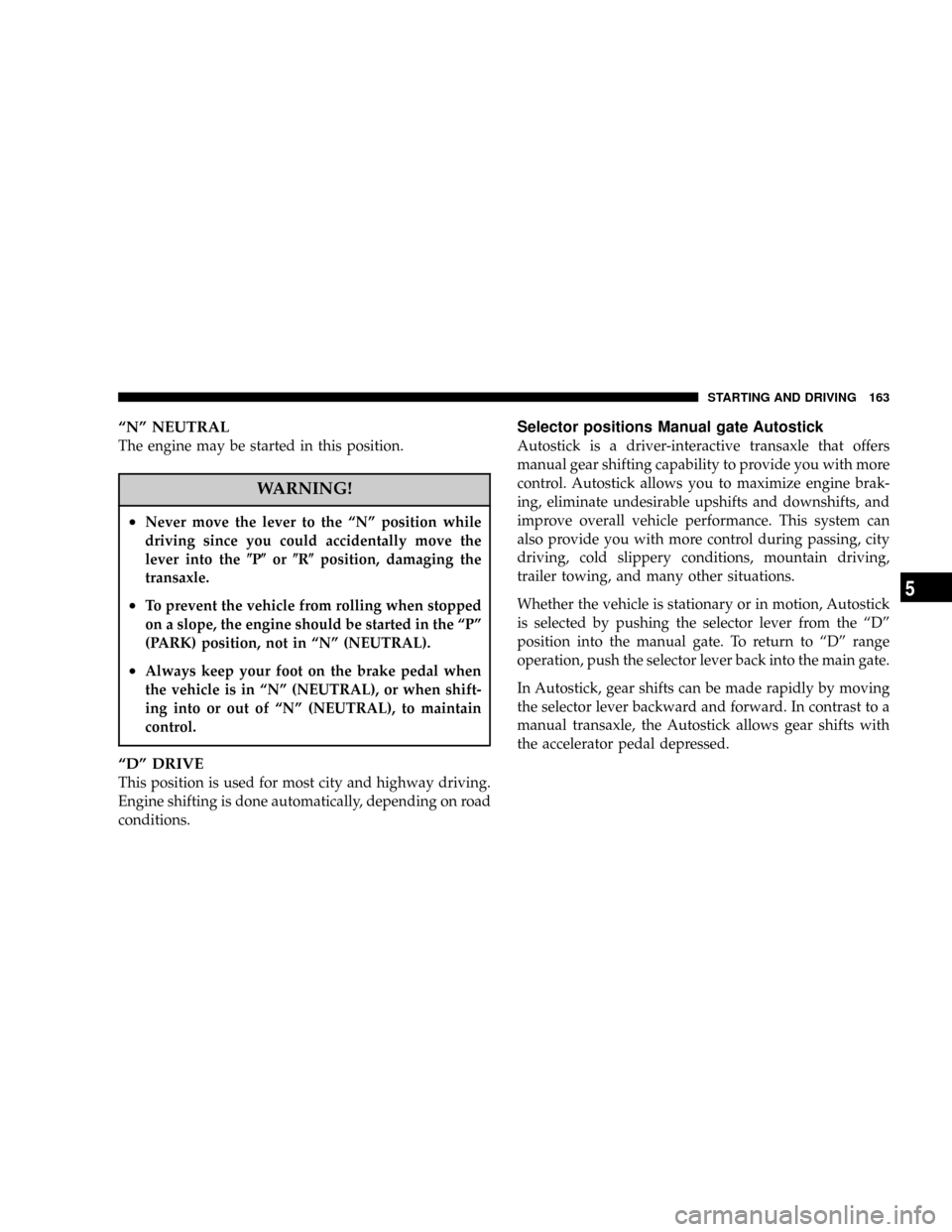Page 143 of 388
mCruise/speed control....................189
NTo activate...........................190
NTo deactivate.........................194
NTo resume the set speed.................195
mTraction control (if so equipped)...........196
mCatalytic converter.....................197
mVehicle preparation before driving..........199
NSeat belts and seats....................199
NDefrosters...........................199
NTires...............................199NLights..............................200
NFluid leaks..........................200
NDriver..............................200
mSafe driving techniques..................200
mDriving, alcohol and drugs...............201
mTips for driving in various conditions........201
mOperation during cold weather............202
mTrailer Towing.........................203
NWarranty Requirements.................203
STARTING AND DRIVING 143
5
Page 144 of 388

BREAK-IN RECOMMENDATIONS
Advanced automobile manufacturing techniques permit
you to operate your new vehicle without experiencing a
long break-in period of low-speed driving.
However, you can add to the future performance and
economy of your vehicle by observing the following
precautions during the first 300 miles (500 km).
It is recommended that you drive your vehicle at mod-
erate speeds during the break-in period.
1. Avoid racing the engine.
2. Avoid harsh driving such as fast starts, sudden accel-
eration, prolonged high-speed driving and abrupt appli-
cation of the brakes. These operations not only have a
detrimental effect on the engine but also cause increased
fuel and oil consumption, which could result in malfunc-
tion of engine components. Be particularly careful to
avoid wide-open throttle acceleration in low gear.
3. Do not overload the vehicle. Observe the seating
capacity. (See ªWeightsº page 365)
4. Do not use this vehicle for trailer towing during the
break-in period.
FUEL SELECTION
Your vehicle is designed to use unleaded gasoline only. It
is equipped with a fuel filler tube especially designed to
accept only the smaller diameter unleaded gasoline dis-
pensing nozzle.
WARNING!
Gasoline is highly flammable and explosive. You can
be burned or seriously injured when handling it.
When refueling this vehicle, always turn the engine
off and keep flames, sparks, and smoking materials
away. Always handle fuel in well-ventilated outdoor
areas.
144 STARTING AND DRIVING
Page 163 of 388

ªNº NEUTRAL
The engine may be started in this position.
WARNING!
²Never move the lever to the ªNº position while
driving since you could accidentally move the
lever into the(P(or(R(position, damaging the
transaxle.
²To prevent the vehicle from rolling when stopped
on a slope, the engine should be started in the ªPº
(PARK) position, not in ªNº (NEUTRAL).
²Always keep your foot on the brake pedal when
the vehicle is in ªNº (NEUTRAL), or when shift-
ing into or out of ªNº (NEUTRAL), to maintain
control.
ªDº DRIVE
This position is used for most city and highway driving.
Engine shifting is done automatically, depending on road
conditions.
Selector positions Manual gate Autostick
Autostick is a driver-interactive transaxle that offers
manual gear shifting capability to provide you with more
control. Autostick allows you to maximize engine brak-
ing, eliminate undesirable upshifts and downshifts, and
improve overall vehicle performance. This system can
also provide you with more control during passing, city
driving, cold slippery conditions, mountain driving,
trailer towing, and many other situations.
Whether the vehicle is stationary or in motion, Autostick
is selected by pushing the selector lever from the ªDº
position into the manual gate. To return to ªDº range
operation, push the selector lever back into the main gate.
In Autostick, gear shifts can be made rapidly by moving
the selector lever backward and forward. In contrast to a
manual transaxle, the Autostick allows gear shifts with
the accelerator pedal depressed.
STARTING AND DRIVING 163
5
Page 203 of 388

WARNING!
Never open the radiator cap when the radiator is hot.
You could be seriously burned.
TRAILER TOWING
Warranty Requirements
The Manufacturer's Passenger Vehicle Warranty will
apply to vehicles used to tow trailers for non-commercial
use. However the following conditions must be met:
²The maximum trailer load for vehicles with manual
transaxles is 1,000 lbs (454 kg).
²The maximum trailer load for vehicles with automatic
transaxles is 1,000 lbs (454 kg).
²The maximum frontal area of the trailer cannot exceed
20 square feet (1.86 square meters).
²If using a manual transaxle vehicle for trailer towing,
all starts must be in FIRST gear to avoid excessive
clutch slippage.The trailer tongue load must be considered as part of the
tow vehicle load capacity when loading the vehicle.
NOTE:Check the automatic transmission fluid level
before towing. Fluid discoloration, or a burnt odor,
shows the need for transmission fluid replacement.
WARNING!
Connecting trailer brakes to your vehicle's hydraulic
brake lines can overload your brake system and
cause it to fail. You might not have brakes when you
need them and could have an accident.
Whenever you pull a trailer, regardless of the trailer size,
stop lights and turn signals on the trailer are recom-
mended for motoring safety.
STARTING AND DRIVING 203
5
Page 204 of 388
Weight limits
Never exceed the maximum trailer weight (A), maximum
tongue weight (B), Gross Vehicle Weight Rating (GVWR)
and Gross Axle Weight Rating (GAWR).
I26A1290
204 STARTING AND DRIVING
Page 388 of 388

Snow tires.......................... 339
Spare tire........................... 266
Tire chains.......................... 339
Tread wear indicators.................. 337
Tools................................ 266
Towing.............................. 284
Trailering........................... 203
Trailer Towing......................... 203
Transaxle
Automatic transaxle................... 153
Autostick........................... 163
Manual transaxle..................... 166
Transmission
Automatic transmission................ 158
Transmitter, Garage Door Opener........... 132
Transporting Pets....................... 102
Trip odometer......................... 106
Trip odometer reset button................ 106
Trunklid .............................. 35
Turbocharger boost gauge................ 106
Turn signal indicators.................107,112
Lever.............................. 122Uniform Tire Quality Grades.............. 379
Universal Transmitter.................... 132
Vanity mirror.......................... 209
Vehicle Identification Number............... 5
Vehicle labeling........................ 364
Vehicle Weights........................ 367
Ventilators............................ 235
Warnings and Cautions.................... 5
Warranty Information.................... 374
Washer fluid level indicator............... 107
Washer
Windshield.......................128,331
Washing.............................. 255
Waxing.............................. 257
Wheel covers.......................... 268
Whip antenna......................... 219
Windshield washers..................128,331
Windshield wiper blades................. 331
Windshield wipers...................... 126
388 INDEX